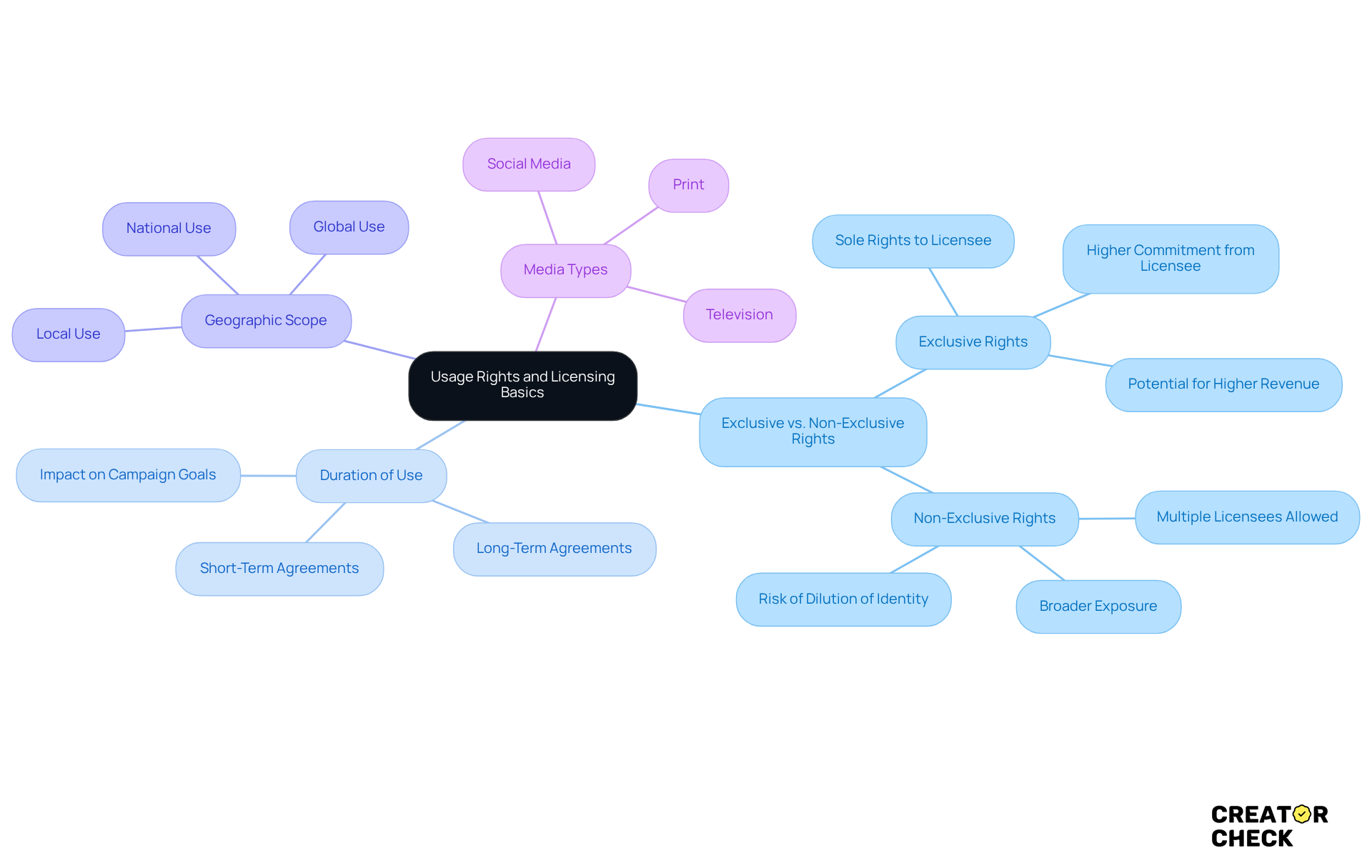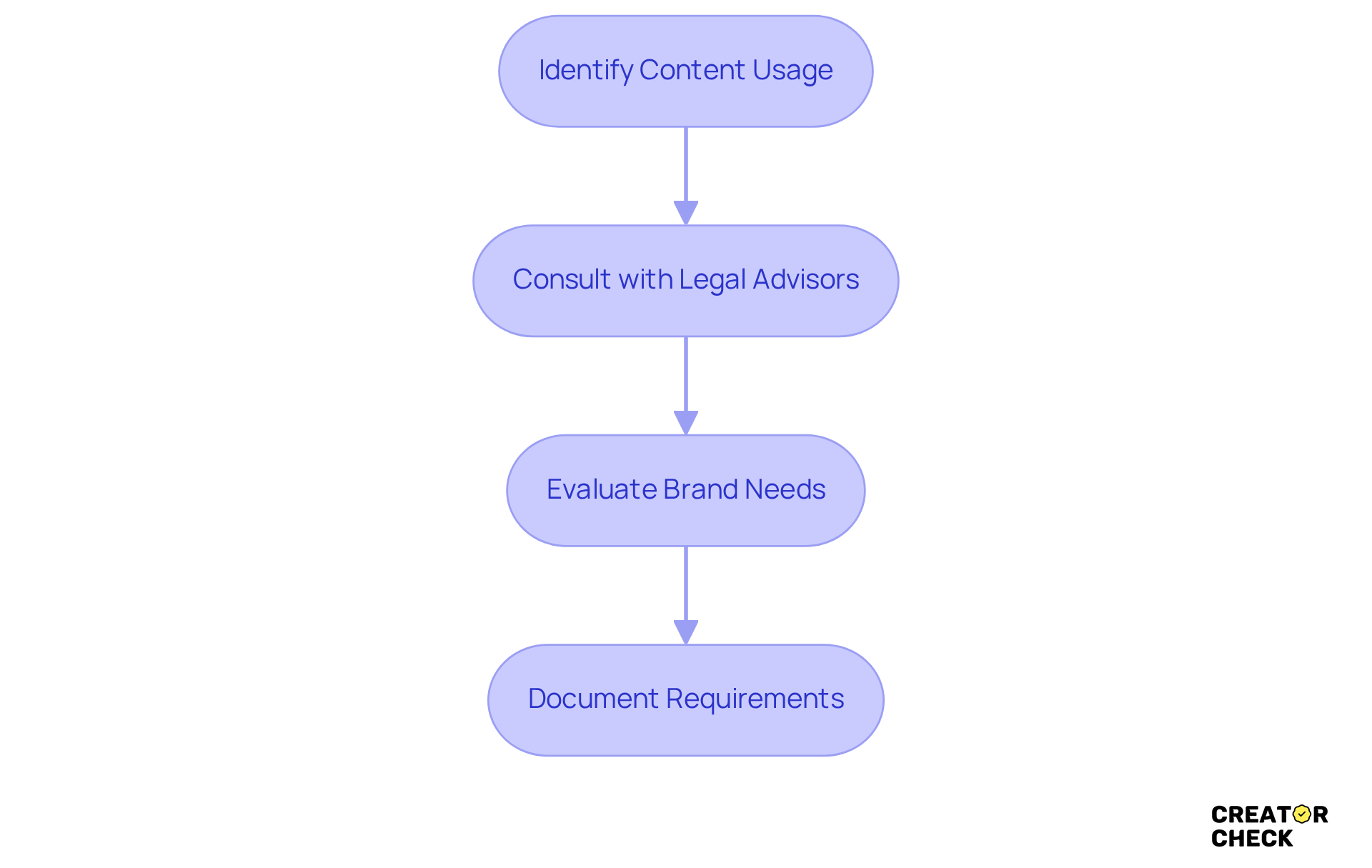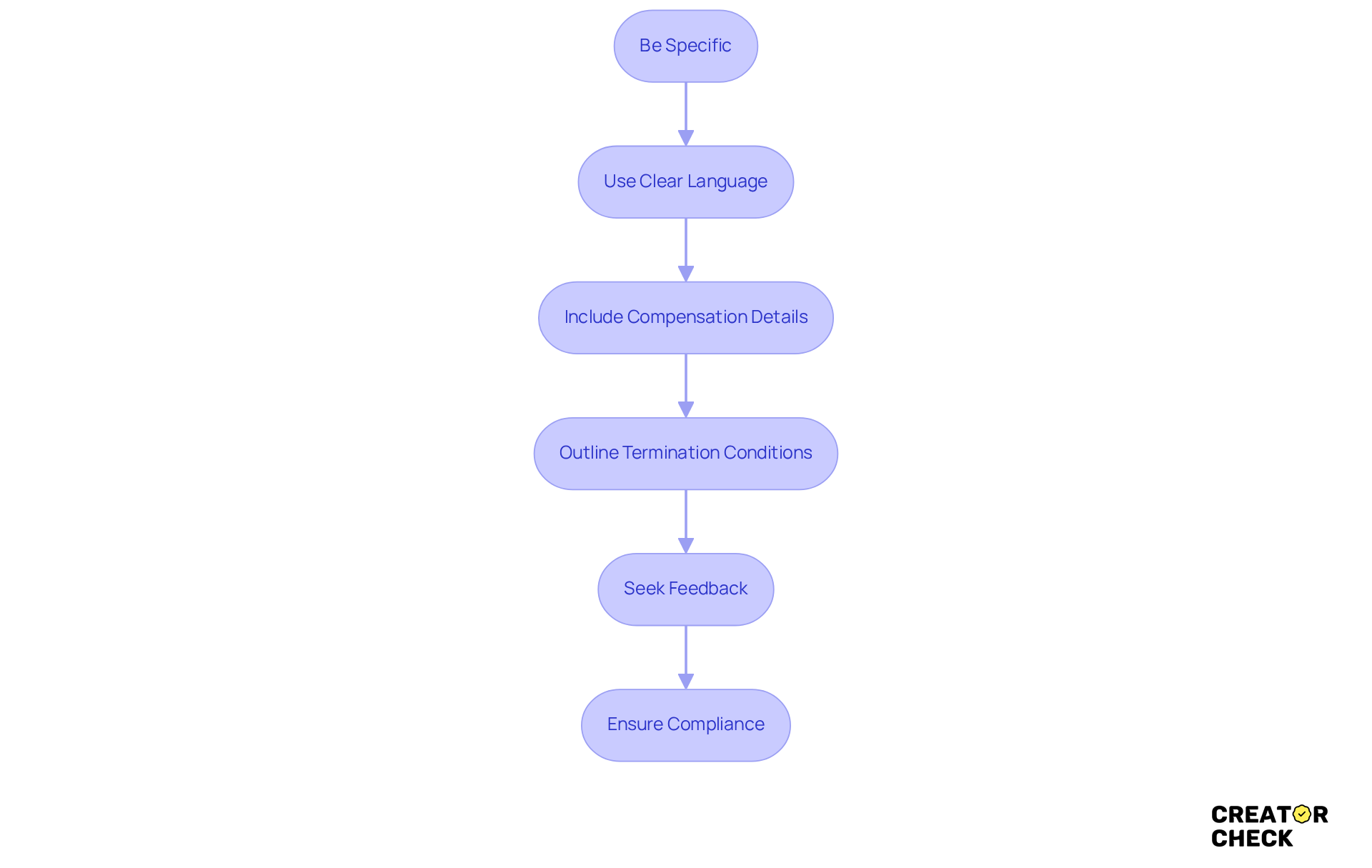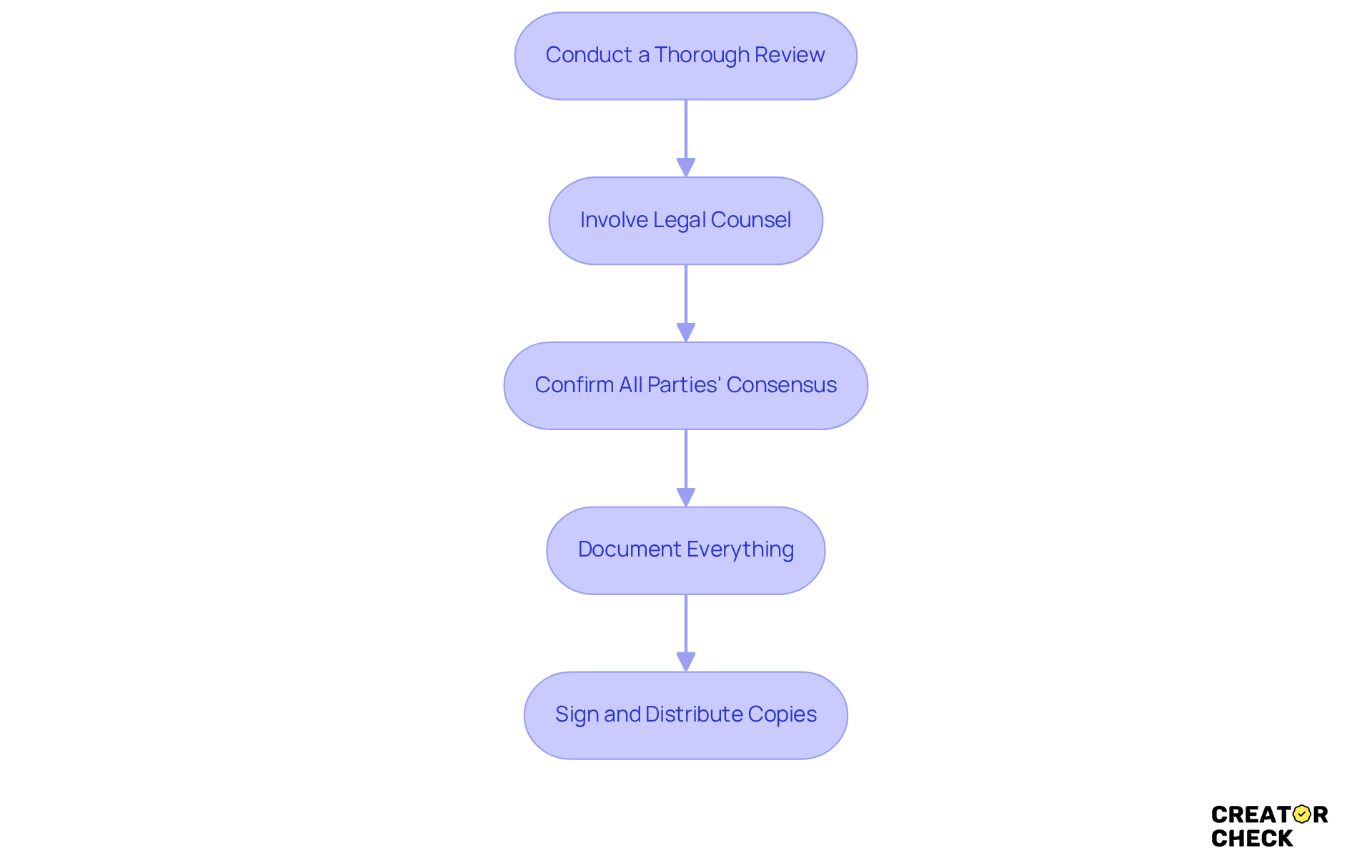Overview
This article shares four key steps to help you configure usage rights and licensing in your deal proposals:
- Understanding the basics of usage rights.
- Assessing your licensing requirements.
- Drafting clear licensing terms is essential.
- Reviewing agreements thoroughly.
Each of these steps highlights the importance of clarity, legal compliance, and collaboration between creators and brands. This way, both parties' rights and expectations are well-defined and protected throughout the negotiation process. So, what does this mean for you? It’s all about making sure everyone is on the same page and feels secure in the agreement!
Introduction
Navigating the intricate landscape of usage rights and licensing can feel overwhelming for many professionals involved in deal proposals. It’s essential to understand the differences between exclusive and non-exclusive rights, along with the implications of duration and geographic scope. These nuances are crucial for crafting effective agreements that benefit both creators and brands. But with so many variables at play, how can you ensure that all licensing requirements are met while fostering positive collaborations?
This article is here to help! We’ll outline a clear, step-by-step guide to configuring usage rights and licensing in deal proposals. By following these tips, you’ll empower influencers and agencies to streamline their processes and enhance the quality of their partnerships. So, let’s dive in and make this journey a bit easier together!
Understand Usage Rights and Licensing Basics
Usage entitlements pertain to the approvals a company or agency obtains to use a creator's content in specific ways, and it is essential to configure usage rights and licensing in deal proposals to formalize those approvals. Let’s break down some key concepts:
-
Exclusive vs. Non-Exclusive Rights: Exclusive rights mean the creator can’t license the same content to other brands. This creates a stronger commitment from the licensee, who’s likely to put more effort into promoting and commercializing the intellectual property. On the flip side, non-exclusive rights allow multiple companies to use the same content. This can lead to broader exposure, but it might dilute the creator's identity. Interestingly, a significant percentage of companies opt for exclusive rights in influencer agreements, recognizing the competitive edge it brings.
-
Duration of Use: This tells us how long the brand can use the content. The time frame can really vary—from just a few months to several years—depending on the contract terms and campaign goals.
-
Geographic Scope: This aspect defines where the content can be used, whether that’s locally, nationally, or globally. Brands often want to expand their reach, so this becomes a key point during negotiations.
-
Media Types: Different media formats, like social media, print, or television, might need separate licensing agreements since each platform has its own requirements and ways to engage the audience.
Legal experts emphasize that choosing between exclusive and non-exclusive rights should align with the brand's long-term strategy and market positioning. Mindy Taylor puts it well: "Because they hold exclusive rights, they’re more likely to dedicate resources to promoting, developing, and commercializing the IP."
So, understanding these fundamentals is super important for effectively navigating the complexities of deal proposals, especially to configure usage rights and licensing in deal proposals.

Assess Licensing Requirements for Your Proposal
To effectively assess licensing requirements for influencer deals, let’s walk through some essential steps together:
-
Identify Content Usage: First things first, you’ll want to clearly define how the content will be used. Are we talking social media posts, advertisements, or website features? This clarity helps in outlining the extent of the agreement.
-
Consult with Legal Advisors: Next up, it’s time to engage with legal professionals. They can help you navigate the complexities of authorization options. Their expertise is super important for ensuring compliance with copyright laws and understanding the implications of various licensing terms.
-
Evaluate Brand Needs: Now, let’s collaborate with the brand to nail down their expectations regarding content usage. Think about factors like duration and exclusivity. This dialogue is key for aligning both parties' interests and ensuring a win-win agreement.
-
Document Requirements: Finally, compile a comprehensive checklist of all permit requirements based on the evaluations above. Having this documentation serves as a handy reference to make sure all aspects of the proposal are addressed, minimizing the risk of oversight during negotiations.
By following these steps, influencer agencies can effectively configure usage rights and licensing in deal proposals to enhance their overall quality. It’s all about meeting legal standards while effectively addressing the needs of both creators and brands. So, what does this mean for you? It’s an opportunity to streamline your process and foster better partnerships!

Draft Licensing Terms for Deal Proposals
When you're drafting licensing terms, it's important to keep a few key guidelines in mind to ensure everything is clear and protects both parties involved:
-
Be Specific: Make sure to clearly outline the privileges being granted. This includes details like exclusivity, duration, geographic scope, and media types. For example, specify whether the content can be used on social media, in advertisements, or on other platforms, and for how long.
-
Use Clear Language: Try to avoid legal jargon. Instead, use straightforward language that everyone can easily understand. This approach helps reduce misunderstandings and fosters a cooperative environment—essential for effective communication in influencer contracts.
-
Include Compensation Details: It's crucial to specify how the creator will be compensated for the licensing privileges. This could be through a flat fee, royalties, or a combination of both. Did you know that clear compensation models can significantly boost creator satisfaction and engagement? That's why it's vital to outline these terms explicitly.
-
Outline Termination Conditions: Make sure to define the conditions under which either party can terminate the agreement. This way, both parties are protected and aware of their rights in case something unexpected comes up.
-
Seek Feedback: Share the draft with both the creator and the brand for feedback. This collaborative step helps ensure that everyone is on the same page regarding expectations and terms before you finalize the agreement, reducing the chances of disputes later on.
-
Ensure Compliance: Don’t forget to adhere to FTC guidelines concerning disclosures and usage permissions. Clearly defining how to configure usage rights and licensing in deal proposals can prevent future disputes and ensure transparency in sponsored content.
By following these guidelines, influencer agencies can create strong contracts that empower creators while also protecting their interests. So, what does this mean for you? It means you can build better relationships and foster a more positive environment for collaboration!

Review and Finalize Licensing Agreements
To effectively review and finalize licensing agreements, let’s break it down into some simple steps:
- Conduct a Thorough Review: Take a moment to go through the contract line by line. It’s important to ensure that all terms are accurate and truly reflect the discussions you've had.
- Involve Legal Counsel: Don’t hesitate to bring in a legal professional to review the contract. They’ll help ensure everything complies with laws and regulations.
- Confirm All Parties' Consensus: Before you sign, make sure both the creator and the brand are on the same page with the terms. It’s all about agreement!
- Document Everything: Keep a record of all communications and revisions made during the negotiation process. This will be super helpful for future reference.
- Sign and Distribute Copies: Once everything is finalized, make sure all parties sign the agreement and distribute copies for their records.
So, what does this mean for you? By following these steps, you can navigate the licensing agreement process with confidence and clarity!

Conclusion
Configuring usage rights and licensing in deal proposals is super important for building clear and effective partnerships between brands and content creators. When you get the basics of usage rights—like the difference between exclusive and non-exclusive rights, duration, geographic scope, and media types—it really helps everyone navigate the sometimes tricky world of licensing agreements with confidence.
In this article, we’ve laid out some essential steps for figuring out licensing requirements, drafting clear terms, and finalizing agreements:
- Pinpoint how content will be used
- Chat with legal advisors
- Make sure everything complies with regulations
Each step is key to creating contracts that protect everyone’s interests. Plus, focusing on clear communication and collaboration really helps create a positive vibe for successful partnerships.
So, what’s the takeaway? The importance of properly configuring usage rights and licensing can’t be stressed enough. By making these practices a priority, brands and creators can not only protect their rights but also boost their collaborative efforts, leading to more fruitful and engaging content creation. Embracing these strategies will definitely pave the way for stronger relationships in the ever-evolving world of influencer marketing.
Frequently Asked Questions
What are usage entitlements in the context of content licensing?
Usage entitlements refer to the approvals a company or agency obtains to use a creator's content in specific ways, and they are essential to configure usage rights and licensing in deal proposals.
What is the difference between exclusive and non-exclusive rights?
Exclusive rights mean the creator cannot license the same content to other brands, leading to a stronger commitment from the licensee. Non-exclusive rights allow multiple companies to use the same content, which can lead to broader exposure but may dilute the creator's identity.
Why do many companies prefer exclusive rights in influencer agreements?
Many companies opt for exclusive rights because it provides a competitive edge, leading to a stronger commitment from the licensee to promote and commercialize the intellectual property.
How does the duration of use affect content licensing?
The duration of use specifies how long a brand can use the content, which can range from a few months to several years, depending on the contract terms and campaign goals.
What does geographic scope refer to in content licensing?
Geographic scope defines where the content can be used, whether locally, nationally, or globally, and is a key point during negotiations as brands often want to expand their reach.
Why might different media types require separate licensing agreements?
Different media formats, such as social media, print, or television, have their own requirements and ways to engage the audience, necessitating separate licensing agreements for each platform.
What should brands consider when choosing between exclusive and non-exclusive rights?
Brands should align their choice of exclusive or non-exclusive rights with their long-term strategy and market positioning, as emphasized by legal experts.




